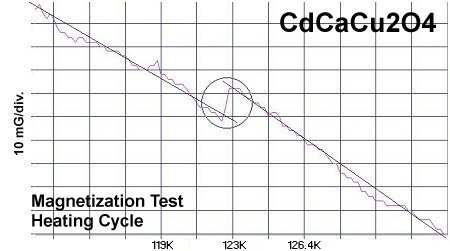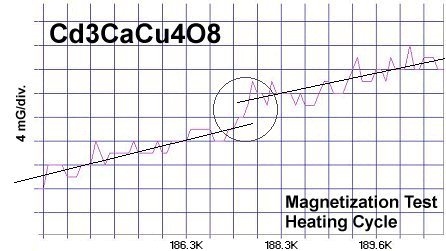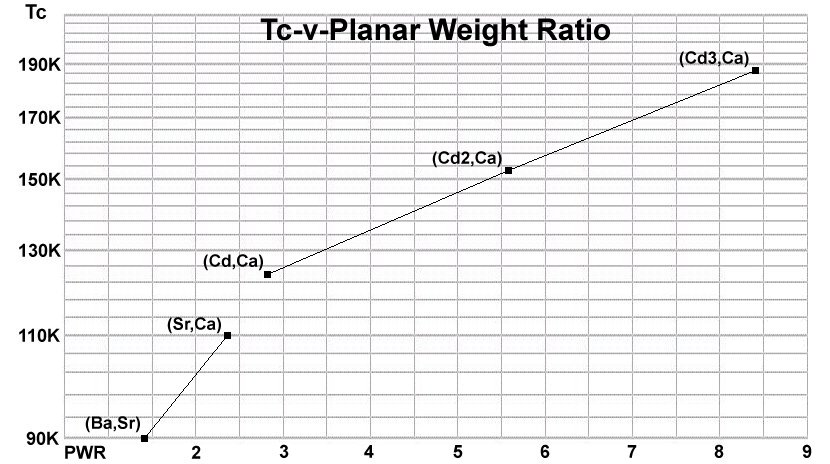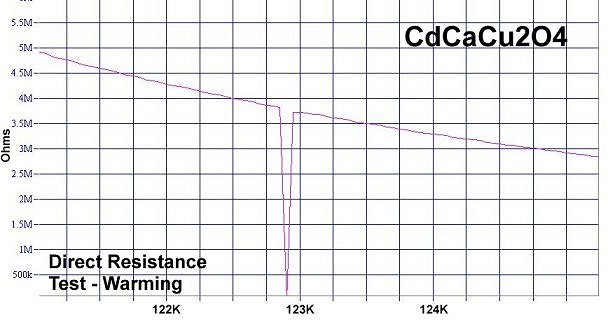

A New Infinite Layer Superconductor System
With Tc's Up To 187 Kelvin
8 March 2016
Superconductors.ORG
Infinite layer superconductors have always been the neglected stepchild of the copper-oxide family. Their 02"∞-1"∞ structure (shown below left) is anything but glamorous.
And to-date they have only accepted alkali earth and rare earth elements as building blocks. This has limited their critical
transition temperatures to about 110 Kelvin and their research appeal. However, this situation has just changed with the discovery of a new infinite layer superconductor system featuring cadmium and calcium.
The plots at page top
show Meissner transitions near 123K for CdCaCu2O4 and 153K for Cd2CaCu3O6.
Then below, an incredible 187 Kelvin Tc results for
Cd3CaCu4O8. Straight lines have been drawn through the noise to represent the average of the data points, skewing apart at Tc. Note that the volume fraction for all three materials is low.

|

The inspiration for this
discovery was the infinite layer superconductor (Sr,Ca)CuO2. Since 2005 it's been known that planar weight disparity is a key component of high-temperature superconductivity. In (Sr,Ca)CuO2, strontium and calcium create weight disparity across the apical oxygen ions. In searching for a possible substitute for strontium, cadmium was found to have a comparable ionic radius. And its +2 oxidation state was a perfect match. So, with its higher planar weight ratio, cadmium appeared to be the ideal complement for calcium in this structure. In the below plots, the graphs of Tc-v-PWR compare favorably for this new family of (2b,2a) superconductors vis-a-vis the legacy (2a,2a) superconductors.
|

To confirm superconductivity, the parent compound CdCaCu2O4 was tested resistively and produced a "Mott transient" in all three direct resistance tests (see below). Mott transients result when a minority phase superconductor warms through its Tc and releases a flood of formerly-paired electrons into the non-superconductive bulk. This transient event causes a momentary increase in electron density and actively dopes the bulk into a metallic state. To read more on this phenomenon, click HERE.

Stoichiometric amounts of the below chemicals were used in the synthesis of these three compounds:
CdO 99.998% (Alfa Aesar)
CaCO3 99.95% (Alfa Aesar)
CuO 99.995% (Alfa Aesar)
The chemical precursors were pelletized at 50,000 PSI and calcined for
1 hour at 770C. The pellet was then sintered for 10 hours at 880C and annealed for 10+ hours at 500C in flowing O2.
Temperature was determined using an
Omega type "T" thermocouple and precision OP77 DC amplifier. The magnetometer employed twin Honeywell SS94A1F
Hall-effect sensors with a tandem sensitivity of 50 mv/Gauss.
RESEARCH NOTE: The copper-oxides are strongly hygroscopic.
All tests should be performed immediately after annealing.
RE-PUBLICATION NOTICE: Elsevier Publishing, dba Elsevier Science, as well as Morris Communications,
both print and broadcast divisions, are specifically prohibited from re-publishing any part of this news story.
E. Joe Eck
© 2016 Superconductors.ORG
All rights reserved.
 BACK to "News" page at Superconductors.ORG
BACK to "News" page at Superconductors.ORG









 BACK to "News" page at Superconductors.ORG
BACK to "News" page at Superconductors.ORG